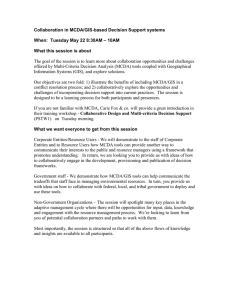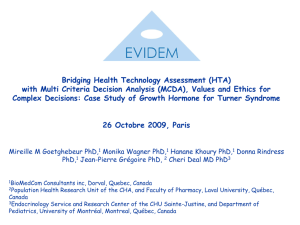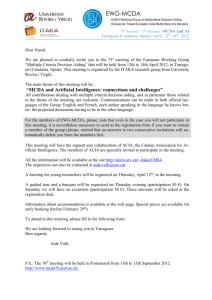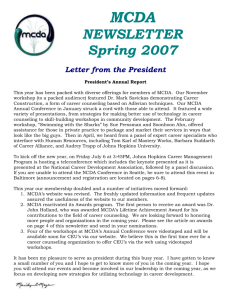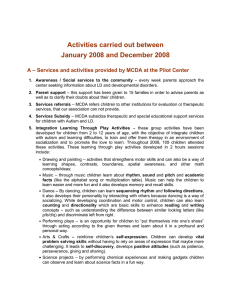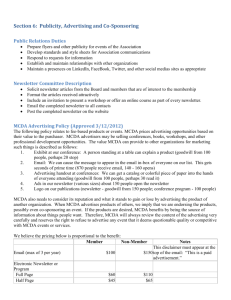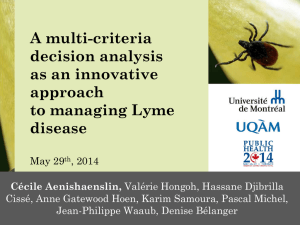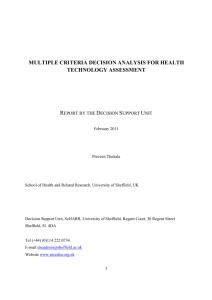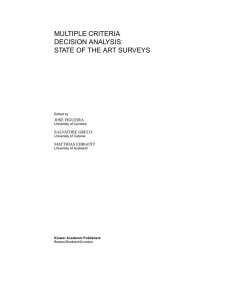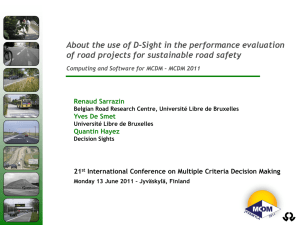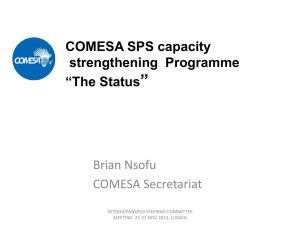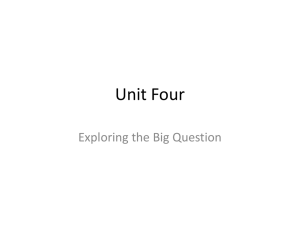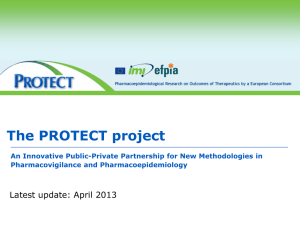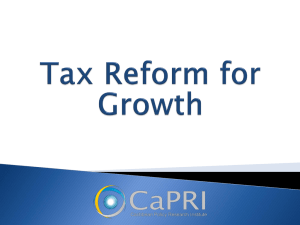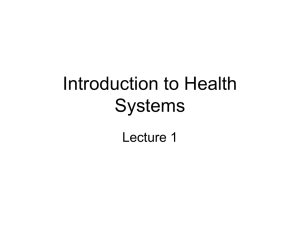Experiences from the interactive use of MCDA in
advertisement
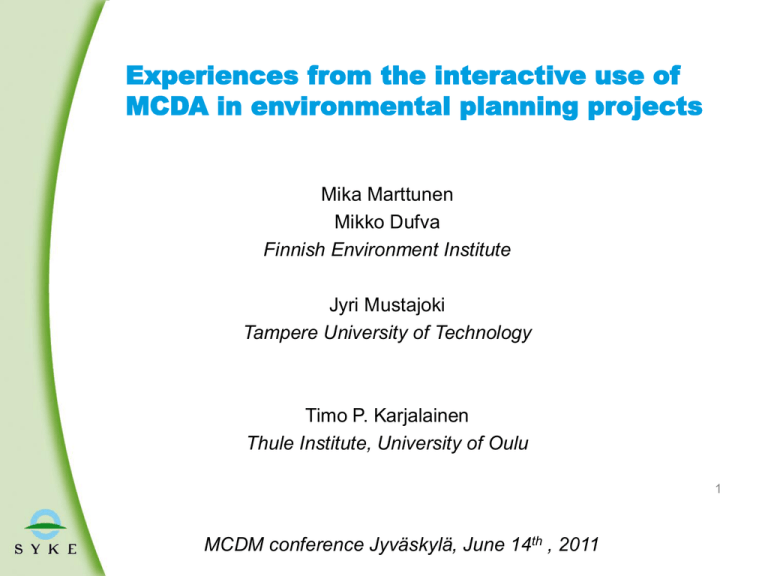
Experiences from the interactive use of MCDA in environmental planning projects Mika Marttunen Mikko Dufva Finnish Environment Institute Jyri Mustajoki Tampere University of Technology Timo P. Karjalainen Thule Institute, University of Oulu 1 MCDM conference Jyväskylä, June 14th , 2011 Content ● Decision analysis interview (DAI) approach ● What do integration and interaction mean in MCDA projects? ● What has been the performance of our MCDA projects in respect of integration and interaction? ● What are the benefits of high level integration and interaction? ● Concluding remarks 13.4.2015 Development of the DAI approach ● Refers to an MCDA process which is based on personal interviews with a multi-criteria model ● Developed in the beginning of 1990’s ○ Close co-operation with SYKE and Systems Analysis Laboratory ● REAL NEED: Water course regulation development projects ○ Conflicting interests and opinions ○ Alternatives with economic, social and ecological impacts ○ Stakeholders’ participation in the planning process ● CHALLENGE: Linking science into practical applications ○ Primary goal in designing processes which are meaningful and effective in joint solution finding 3 Decision analysis interview approach FRAMING, ASSESSMENT AND PRELIMINARY EVALUATION STAKEHOLDERS’ OBJECTIVES AND ALTERNATIVES Identifying and structuring objectives and developing alternatives Value tree ALTERNATIVES’ IMPACTS STAKEHOLDERS’ VIEWS Defining attributes, scales and performance scores Studying workbook material and answering the questionnaire Impact matrix Preliminary significance of the impacts INTERACTIVE USE OF MCDA SOFTWARE Discussion of the responses to the questionnaire Modifications to the value tree and to the performance scores Attributes’ weights, arguments and consistency-checking SYNTHESIS AND RECOMMENDATIONS Different perspectives and value profiles Issues of agreement and disagreement Analysis of the results Major MCDA projects Project Year Scope Tool Personal DAIs Oulujärvi 1992 Water course regulation HIPRE3 Yes, 35 Kokemäenjoki I 1993 Flood risk management HIPRE3+ Yes, 24 Päijänne 1998 Water course regulation HIPRE3+ Yes, 20 Pirkanmaa 2002 Water course regulation Customized model Yes, 35 Koitere 2005 Water course regulation Customized model Value-focused thinking Yes, 18 Plavinas 2006 Hydro power Web-HIPRE No, expert group Mäntsälä 2006 Lake restoration EXCEL No, expert group Ylä-Lappi 2008 Forest management Web-HIPRE Yes, 15 Mustionjoki 2010 River rehabilitation Web-HIPRE Value-focused thinking Yes,12 Iijoki 2011 River rehabilitation Web-HIPRE Value-focused thinking Yes, 25 Keski-Suomi 2011 Peat production EXCEL No, expert group Catermass Ongoing Agriculture Web-HIPRE Open Kokemäenjoki II Ongoing Flood risk management Open Open Rovaniemi Ongoing Flood risk management Web-HIPRE Open Pielinen Ongoing Water course regulation Web-HIPRE Open 5 Primary objectives of the projects Project Systematic and transparent evaluation of alternatives Oulujärvi Identification of information gaps and uncertainties Understanding stakeholders’ preferences Learning of participants Joint solution finding x x x Kokemäenjoki I x x x Päijänne x x x x Pirkanmaa x x x x Koitere x x x x Plavinas x Mäntsälä x Ylä-Lappi x x x x Mustionjoki x x x x x Iijoki x x x x x Keski-Suomi x 6 Integration –definition and criteria ● Integration ○ How MCDA is linked to the planning process and how it supports various phases of the process. ● Criteria/questions ○ When was MCDA introduced into the process? ○ How MCDA affected the design and realization of the planning process? • How well were the phases of MCDA and the planning process integrated? ○ How MCDA’s results were used in decision making? • What was steering group’s role in MCDA? Interaction –definition and criteria ● Interaction ○ How key stakeholders are involved in the various phases of the process and how the weight elicitation and analysis of the results are carried out. ● Criteria/questions ○ Who were involved? • Did participants cover a wide spectrum of views? ○ Did participants have an opportunity to give their input to all phases of MCDA? ○ How interactive was the modelling phase? 8 Evaluation of the projects Mustionjoki (2010) Very high Pirkanmaa (2002) Koitere (2005) Päijänne (1998) Integration of MCDA Mäntsälä (2007) Kokemäenjoki (1993) Oulujärvi (1992) Iijoki (2010) Plavinas (2006) Keski-Suomi (2011) Ylä-Lappi (2008) Low Low Interaction of MCDA Very high Mustionjoki-project: Comparing different mitigation measures to enhance freshwater mussel and salmon populations ● MCDA provided a framework and a roadmap for the project. ● Stakeholder steering group (8 persons) actively participated from the beginning of the project ○ 10 meetings and two workshops ● Value-focused thinking was used in the structuring phase. ● 12 face-to-face interviews were carried out with WebHIPRE. ● Project lasted 8 months. 10 The benefits of integration and interaction ● The levels of integration and interaction have a crucial impact on the quality and effectiveness of the MCDA process and its outcomes. ○ Acceptability of the process and outcome improves ● The pros of integrated and interactive process: Improved consistency Enhanced learning Improved fairness and transparency Improved trust toward the results Sustained interest of participants on the process 11 13.4.2015 Taneli Duunari-Työntekijäinen, SYKE Improved consistency ● People have difficulties in assigning consistent and unbiased weights. ○ Splitting bias and range effect ○ Cognitively demanding task to give weights to the uppermost level criteria ● Close interaction between the analyst and the participant in the weight elicitation is necessary. ● The analyst can detect possible misunderstandings, inconsistencies, and biases in participants' answers. ● More carefully answers in the presence of the facilitator than independently. Improved consistency Enhanced learning Improved trust toward the results Improved fairness and transparency Sustained interest of participants on the process 12 13.4.2015 Taneli Duunari-Työntekijäinen, SYKE Enhanced learning ● Value-based and structured approach creates favourable conditions for learning ○ Mutual trust and understanding ”Use of MCDA softened my rigid opinions” ● DAIs inspire learning and understanding in a different manner than traditional meetings and workshops. ○ “Learning by analysing” approach ○ Immediate feedback ○ Iterative approach • Opportunity to modify the weights Improved consistency Enhanced learning Improved trust toward the results Improved fairness and transparency Sustained interest of participants on the process 13 13.4.2015 Taneli Duunari-Työntekijäinen, SYKE Improved trust towards the results ● Due to the interactive use…. ○ People see how their answers are used as input values for the analysis and also how they affect the outcome. ○ It is possible to ensure that the participants have a sufficient understanding of the MCDA model. ○ The risk that people are feeling being manipulated by a "black-box" methodology reduces. => Stakeholders’ trust toward the model, results and the whole planning process increases. Improved consistency Enhanced learning Improved trust toward the results Improved fairness and transparency Sustained interest of participants on the process 14 13.4.2015 Taneli Duunari-Työntekijäinen, SYKE Improved fairness and transparency ● The personal decision analysis interview is a good way to provide each participant an opportunity to express her opinions and to get one's opinion equally documented. ● DAIs may have positive impacts on the perception of the fairness of the planning processes. ● DAIs signal that the problem owner had a genuine aspiration to identify and balance different interests and objectives. Improved consistency Enhanced learning Improved trust toward the results Improved fairness and transparency Sustained interest of participants on the process 15 13.4.2015 Taneli Duunari-Työntekijäinen, SYKE Sustained interest of participants on the process ● In the projects lasting several years it is a big challenge to keep participants active and committed. ● The integrated and interactive use of the MCDA helps in realizing meaningful and effective stakeholder processes. Improved consistency Enhanced learning Improved trust toward the results Improved fairness and transparency Sustained interest of participants on the process 16 13.4.201 Taneli Duunari-Työntekijäinen, SYKE Concluding remarks ● MCDA has a very good image in water resources planning ○ ”Soft” participatory approach and successful projects ● Strong support in ministries and SYKE’s management ○ Implementation of EU Floods Directive and Water Framework Directive ○ New arenas: Improving EIA and SEA by adopting good practices and tools of MCDA (EU Life+ application) ● Gap between MCDA’s potential and its current use ○ Great need for integrated and participatory approaches in environmental planning and management ○ Lack of MCDA experts ● Integrating MCDA into the planning process is not an easy goal but worth of striving ○ Easiest when the analyst acts also as the project manager. 17 13.4.2015 Taneli Duunari-Työntekijäinen, SYKE THANK YOU FOR YOUR ATTENTION! THANK YOU! Raimo • Marttunen, M. and Hämäläinen, R.P. 2008. Decision analysis interviews in supporting collaborative management of a large regulated water course. Environmental Management 42 (6): 1026-1042. • Hämäläinen, R.P, Mustajoki, J. and Marttunen, M. 2010. Web -based Decision Support: Creating a culture of applying multi-criteria decision analysis and web supported participation in environmental decision making. In Rios Insua, D. and French, S. (eds): e-Democracy. A Group Decision and 18 Negotiation Perspective. 2010. XII, 364 p.
